Deputy Director General’s foreword
Phil Gorey
Deputy Director General
Resource & Environmental Regulation Group
This second edition of the Resource and Environmental Regulation Group eNews features a number of updates, including the Validation Bill, which was introduced to Parliament on 28 November 2018. The article includes a link to a copy of the Bill and Explanatory Memorandum. The Bill’s purpose is to provide security for holders of mining tenements.
We also provide details on the proposed reforms to Mining Regulation 169, which will allow authorised agents to represent clients in the Warden’s Court.
In addition, more than 85% of Programme of Work (PoW) applicants are now taking advantage of the benefits associated with the department’s PoW spatial system (PoW-S). Given this uptake by the industry, the Programme of Work-Exploration form (PoW-E) will now be phased out and removed to simplify the selection of application options available. Therefore as of 28 March 2019, all new exploration applications will be required to be submitted using the PoW-Spatial system (PoW-S).
Finally, the Resource Sector Awards for Excellence are open for nominations. The awards evening will be held on 22 August 2019 and includes the Golden Gecko Environmental Excellence Awards; and the Community Partnership Resources Sector Award. You can read about the eligibility criteria in this edition. Submissions close on 29 April 2019.
Dr Phil Gorey
Deputy Director General
Resource and Environmental Regulation Group
Removal of PoW-E form enables earlier field access
- All new exploration applications to be submitted using PoW-S
- Simplified application process reduces proponent effort
- Tailored system feedback results in faster assessment timeframes
With 85% of mineral exploration applicants now using the Programme of Work – Spatial (PoW-S) application form, the old Programme of Work – Exploration (PoW-E) form will be removed from the Department of Mines, Industry Regulation and Safety (DMIRS) website on 28 March 2019. PoW-E applications that commenced, but have not been submitted for assessment by this date, may still be submitted up to three months after the application start date.
Previously, PoW-E applicants had to attach PDF maps and type proposed activities into a static online form. There were often decision delays due to the need to amend the application after DMIRS receives the submission and provides feedback.
PoW-S enables applicants to add their activities more quickly and accurately by either uploading previously prepared spatial files or describing activities ‘on the fly’ using the system’s simple drawing tools.
The system then compares the proposed activities with known areas of environmental and cultural significance and generates customised feedback for consideration. The applicant can then adjust their application prior to submission, minimising potential impacts and reducing assessment delays.
PoW-S has reduced the average decision timeframes by seven days compared to PoW-E applications; and 13 days compared to PoW-P applications.
Prospectors can also submit their applications via PoW-S. Alternatively, they can download and manually complete the PoW-P PDF application form available on the department’s website.
For further information about the removal of the PoW-E form or to learn more about PoW-S, contact the DMIRS EARS Manager on +61 8 9222 3535 or email EARSManager@dmirs.wa.gov.au.
Reform of Mining Regulation 169
Following external stakeholder consultation, a recommendation by the former Mining Industry Liaison Committee (MILC) to draft amendments to regulation 169 of the Mining Regulations 1981 will now be progressed.
This amendment will allow an authorised agent who is not legally qualified to represent a client in the Warden’s Court during the initial stages of proceedings.
The proposed changes will mean that parties would need to sign a prescribed form to acknowledge the consequences of choosing an authorised agent for the initial stages of proceedings. A lawyer would still be required for representation in direction hearings’ and the substantive hearing. This reform is expected to lower the overall costs for Warden’s Court proceedings for prospectors and mining industry participants once the regulatory change is enacted by mid-2019.
Validation Bill update
The State Government introduced the Mining Amendment (Procedures and Validation) Bill 2018 into the Legislative Assembly on 28 November 2018.
The purpose of the legislation is to provide security for holders of mining tenements, now and in the future, following the 2017’s High Court decision in Forrest & Forrest Pty Ltd v Wilson & Ors [2017] HCA 30.
The High Court case generated uncertainty about the validity of mining tenements, which were processed in good faith and in accordance with the previous practices and understanding of the law at the time they were granted.
The Bill provides certainty for the mining sector by, firstly, validating mining tenements, and secondly, clarifying and streamlining the application and determination provisions of the Mining Act 1978 (Mining Act) providing security of tenure for future tenement applicants.
Passage of the Bill in the State Parliament will be progressed with reference to complementary amendments required to the Commonwealth’s Native Title Act 1993 (Native Title Act).
This is because there is a risk that the validating legislation itself could be a ‘future act’ for the purposes of the Native Title Act, even though native title rights are addressed before the grant of a tenement.
The State has therefore requested the Commonwealth make an amendment to the Native Title Act to allow Western Australia to pass the validating legislation without the risk of it jeopardising existing native title agreements.
The State is seeking only to restore the status quo as understood to have existed prior to the High Court decision, without causing any collateral effects, whether advantageous or disadvantageous, on native title holders or native title rights.
The procedural amendments to the Mining Act will make some changes to the way tenement applications are made. The Bill will lessen the administrative burden, making it easier for industry to adhere to the statutory lodgement requirements and reduce the potential for an application to be invalid.
A copy of the Bill and Explanatory Memorandum is available for download.
Rental reduction helps new potash producers
A concessional mining lease rental rate to assist potash project development in Western Australia will be introduced following the December 2018 announcement by the Hon. Bill Johnston, Minister for Mines and Petroleum.
A reduced rental rate for potash projects was found to be more equitable compared to other mineral resources, as the mining leases need to cover extensive areas between 50,000 to 500,000 hectares to provide security over the entire brine resource that lies underneath salt lakes in remote locations.
Potash proponents will need to apply for a standard mining lease, including paying the first year’s rent in advance at the standard rental rate. With their application, proponents can request that the Minister restrict the grant of the mining lease to minerals dissolved in brine (i.e. potash). If the Minister determines to grant a mining lease restricted to minerals dissolved in brine (considering the locality of the land and the public interest), the concessional rate will then apply and the holder will be entitled to seek a refund of the difference in rent paid upon application. Subsequent year rents will be at the reduced rate of $2.32 per hectare, per annum for the first five years and then $4.64 per hectare, per annum onwards.
Resource Sector Awards for Excellence
Nominations close on 29 April 2019
Nominations for the 2019 Resources Sector Awards for Excellence, including the Golden Gecko Awards for Environmental Excellence, and the Community Partnership Resources Sector Award, opened on 25 February 2019 and will close on 29 April 2019.
Community Partnership Resources Sector Award
The Community Partnership Resource Sector Award was introduced in 2016 to recognise outstanding achievements and leadership in community and resource industry partnerships that produce positive outcomes and promote strong guiding behaviour within the resources sector.
This award helps promote and build the reputation of Western Australian resource industry organisations that are working closely with communities, or community groups to understand local concerns and issues, to create positive outcomes; and leave a positive legacy that extends well beyond gaining a social licence to operate.
Foodbank WA & BHP’s Healthy Food for all Pilbara Regional Strategy
In 2018, BHP and Foodbank WA were awarded the Community Partnership Resources Sector Award for their Healthy Food for All – Pilbara Regional Strategy. The Food Sensations suite of programs and School Breakfast program evolved from a long-term partnership that fostered a relationship between students, parents and educators in a social setting to meet children’s’ nutritional needs; and general physical and mental health.
Two certificates of merit were awarded in 2018, one to Yule Brook College for their Makerspace project, which improves opportunities for young people at the college through helping them explore and experience making material artefacts while learning the value of the core disciplines of science, technology, mathematics, arts and engineering. The second certificate was awarded to the Alcoa/Munda Biddi Trail Foundation Partnership, which together works to help build, maintain, promote and foster sustainable support for the Munda Biddi Mountain Bike Trail.
You can read more about the finalists in the Resources Sector Awards for Excellence 2018 commemorative brochure.
Yule Brook College and Carey Mining’s Makerspace Project
How to enter
To be eligible, the resource industry operation and the community group must be able to demonstrate that they are engaged in a collaborative partnership or alliance to provide sustainable and enduring benefits to the Western Australian community in which they are located. Entries can be for a collaboration that is a local activity or company-wide initiative but must be able to demonstrate positive outcomes for the local community.
Eligible entrants will be scored against the following assessment criteria:
- Leadership/innovation in engagement
- Benefits of the partnership
- Sustainability and future of the partnership
This year the department is trialling a more streamlined and transparent application process for the Community Partnership Resources Sector Award. The online form is now in a question and answer format with a strict character limit. Questions for each criterion will be weighted out of a total of 100, providing greater transparency of the judging process. Based on the information provided in the online form the selection committee will shortlist nominations and those partnerships that are shortlisted will have an opportunity to present further information to the selection committee later in the awards process.
Visit www.dmirs.wa.gov.au/excellenceawards for more information or contact the Awards Coordinator by emailing communitypartnerships@dmirs.wa.gov.au.
Golden Gecko Awards for Environmental Excellence
Since it began in 1992, The Golden Gecko Awards have promoted and encouraged advances in environmental management of all aspects of the mineral and petroleum industries in Western Australia.
Industry has come a long way in 26 years. The 2018 entries were of such high standards, that two Golden Gecko Awards were presented to BHP Iron Ore for Chasing Ghosts: Understanding Ghost Bat Ecology in the Pilbara, and to WA Port Authorities and Department of Primary Industries and Regional Development for The State Wide Array Surveillance Program. A certificate of merit was also awarded to Alcoa of Australia for Alcoa and Murdoch University Partnership Eradicates Biological Bulldozer Phytophthora Dieback.
You can read more about the finalists in the Resources Sector Awards for Excellence 2018 commemorative brochure.
Homogenisation of a sample (DNA) of growth collected from the State Wide Array Surveillance Program (SWASP) to protect the States Biodiversity.
How to enter
To be eligible, entries must relate to a resource industry operation; relate to environmental management or research; be based in Western Australia; and have addressed the assessment criteria.
Eligible entrants will be scored against the following assessment criteria:
- Demonstrated excellent environmental outcomes
- Commitment to environmental excellence
- Sets a new industry standard, demonstrates innovation or goes beyond regulatory compliance
- Community engagement and corporate social responsibility
Entries for the awards are encouraged from individuals, companies and organisations.
Alcoa's Huntly Mine Haul Roads and surrounding forests that are susceptible to dieback if not appropriately managed.
Visit www.dmirs.wa.gov.au/excellenceawards for more information or contact the Awards Coordinator by emailing golden.gecko@dmirs.wa.gov.au.
Awards assessment
It is important to note that both the Community Partnership Resources Sector Award and the Golden Gecko Awards are assessed based on the merit of each application, not as a competition between applicants. Small projects are encouraged to apply, as the merit of their project will be assessed taking the size and resources of the individual, company or organisation into consideration.
BHB undertaking VHF Tracking of Ghost Bats as part of their integrated research program in the Pilbara.
Ellendale Diamond Mine expression of interest
When mining started at Ellendale in 2002, it became the main source of the very attractive fancy yellow diamonds on world markets. In July 2015, the Kimberly Diamond Company (KDC), the then owner of the Ellendale Diamond Mine in the west Kimberley, closed the mine with little notice.
Following the closure, KDC went into liquidation; and the liquidators sold off parts of the plant and equipment in an attempt to minimise the financial loss to shareholders. The liquidators then issued a Notice of Disclaimer of Onerous Property under the Commonwealth’s Corporations Act 2001.
In January 2017, the Minister for Mines and Petroleum gazetted a Mining Act 1978 (Mining Act) Section 19 area over Ellendale. Section 19 allows the Minister to invite a company to apply for a new tenement under whatever conditions he thinks are reasonable and appropriate. In order to ensure the process is transparent the Department of Mines, Industry Regulation and Safety (DMIRS) released a Request for Expressions of Interest (REOI) ensuring that all companies with an interest will have an equal opportunity to apply.
DMIRS released the Ellendale REOI in August 2018 on the Tenders WA website and the submission period closed on 30 November 2018. The submissions are being assessed by an expert panel within DMIRS consisting of a geologist, a financial expert, a mining engineer and an environmental scientist. A report is being compiled summarising the submissions and will be provided to the Minister who can choose and invite the most appropriate company to apply for a new tenement.
Confidentiality and security of the submissions and the process is high. DMIRS has a probity consultant overseeing the process to provide the assurance that the submissions are examined with no bias or external influences.
Coinciding with the release of the Ellendale REOI, the Geological Survey Record 2018/8 was released describing the Geology, Resources and Exploration Potential of the Ellendale Diamond Project, West Kimberley, Western Australia, which demonstrated that there are still potential diamond resources remaining at Ellendale. The record notes that these potential diamond-bearing resources remain in the hard rock lamproite pipes, in alluvium derived from erosion of the original volcanic vents, and in landforms of previously processed ore.
Subject to there being a suitable submission that meets the Minister’s and DMIRS requirements, it is anticipated the Minister will invite a company within the first half of 2019.
While Section 19 allows the Minister to set any conditions he likes, it is expected that any new tenement at Ellendale will follow normal Mining Act stipulations and the new tenement holder will be required to comply with all normal Mining Act requirements.
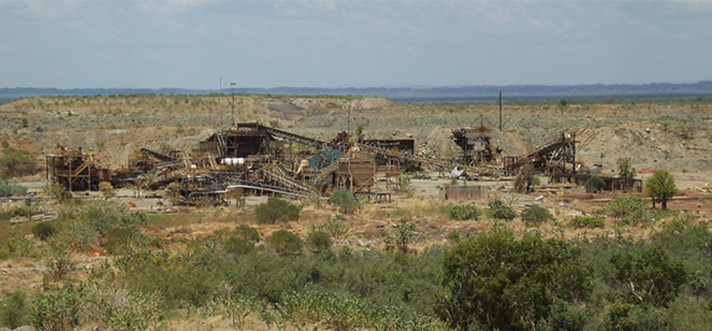
‘Ellendale 9’ plant area in November 2017 looking northerly with overburden landforms behind and the Devonian Reel complex rock on the northern horizon, marking the edge of the Kimberley range country.
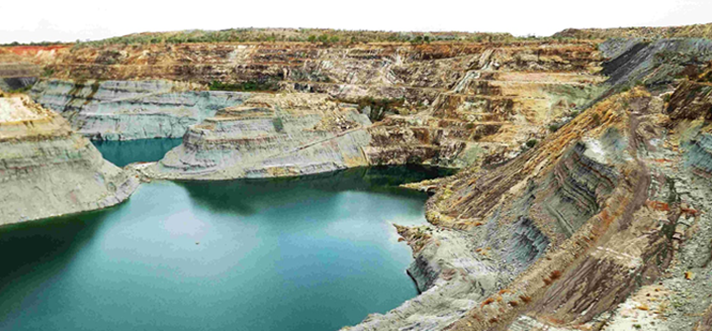
‘Ellendale 9’ open cut mine looking south eastwards. The diamondiferous volcanic rock called Lamproite is the pale bluish-grey rock, the host country sedimentary rock is brown.
Common issues in MRF reporting
To ensure that the Mining Rehabilitation Fund (MRF) data provided by tenement holders is accurate, the Resource and Environmental Compliance Division conducts a vigorous MRF audit or compliance programme each year.
When conducting MRF audits and reviewing the findings the department has found a number of common misunderstandings about what should be reported in an MRF submission. Common misconceptions are detailed below.
Reporting period
Subject to the points below, you are normally required to report any disturbance on the surface of the tenement, whether or not you have undertaken any activity during the current reporting period. This means that, if you have not done any work during this reporting period but have disturbed the land previously, you would normally report the same as you did in the previous period (except for exploration and prospective activity, as explained below).
Ultimately, you report the footprint of the activity as it exists on the day that you assessed it.
‘Rehabilitation’ and ‘Land under Rehabilitation’
A mining activity cannot be considered as ‘rehabilitated’ unless all of the closure obligations in the mining proposal have been met and signed off by an appropriate officer within the Environmental Compliance Branch.
A mining activity cannot be considered as ‘land under rehabilitation’ until all required earthworks have been completed in accordance with closure obligations and you have commenced work toward revegetation and monitoring. If you provide an Annual Environmental Report to the department, this would be consistent with having completed Stage 1 (i.e. Stage 2 rehabilitation has commenced).
‘Historical’ or ‘Legacy’ mining activities or infrastructure
When you purchase a tenement from another party, you effectively inherit all of their rights and obligations as if you, yourself, had held that tenement from the time it was granted. This means that you need to report any mining-related disturbance, whether created by yourself or by a previous holder of the tenement that has not been signed off as fully rehabilitated.
If a disturbance pre-dates the grant of the tenement (for example, old workings, roads or infrastructure), you would not normally need to include them in your report unless you have disturbed them or used them yourself. An example would be re-using old tracks to access your operations, or drilling into old tailings, or re-excavating a pit.
Exploration and prospecting activities
Ordinarily, when you report a mining disturbance, you only need to report the ‘footprint’ of the disturbance that exists on the day that you assessed it. Exploration and prospecting activity (work completed under a Programme of Work) is different.
Instead, when reporting this activity, you need to take into account all of the work that you have done so far under the Programme of Work (POW). The end result is that, each year, you add the area of ground that you’ve disturbed in the current period to what you reported for the previous period until you’ve completed everything that you plan to do under the POW and have completed all of the rehabilitation work. At this point, you would also submit the Exploration Rehabilitation Report (copy provided within the POW form). When MRF reporting in the future, provided that an Exploration Rehabilitation Report has been submitted, you can report that there is ‘no assessment information for this tenement’, because all activities have been completed.
If you have approval to do exploration or prospecting (meaning, a Programme of Work has been approved) but you haven’t yet started work, you will still need to lodge an MRF report but you can report that there is ‘no assessment information to report for this tenement’ because no activities have commenced. In these cases, work that does not involve disturbing the ground (like detecting) does not count as an ‘activity’.
Please contact the MRF Team on +61 8 9222 3162 or e-mail mrfenquiry@dmirs.wa.gov.au if you have any questions about the MRF.
Compliance actions
Quarter 4
1 October 2018 to 31 December 2018
DMIRS Resource and Environmental Compliance Division oversees the Resource and Environmental Compliance Enforcement Panel that considers cases of alleged breaches of tenement conditions under the Mining Act 1978 (WA) (Mining Act) and provides advice to the Minister for Mines and Petroleum on whether forfeiture, or a penalty in lieu of forfeiture, should be imposed.
DMIRS considers it important to raise industry’s awareness of common types of breaches that occur, with the aim of promoting the importance of compliance.
Penalties in Lieu of Forfeiture (PILF) imposed by the Minister for Mines and Petroleum
This is a consolidated list of confirmed Mining Act breach of tenement conditions for the previous quarter that have had a penalty imposed by the Minister for Mines and Petroleum.
|
Penalty |
Nature of Breach |
Learnings for Industry |
Detection By |
Minister’s Decision Date |
No. of Tenements |
Individual or Company |
|
$41,533 |
Failure to comply with tenement conditions and failure to rehabilitate. |
Ensure operations and closure planning is carried out in accordance with legislative requirements. |
Inspection |
3/12/2018 |
3 |
Company |
|
$19,200 |
Alteration or expansion of operations without approval. |
Ensure all approvals have been received before undertaking works and operations. |
Inspection |
27/11/2018 |
3 |
Company |
Approval performance report
Quarter 4
1 October 2018 to 31 December 2018
The end of 2018 marks the 10th anniversary of agency approval performance reporting relevant to the regulation of the WA resource sector.
Table 1 in this report features the number of applications received for each year since the approval performance reports commenced in 2009.
In the December Quarter 2018, the report focusses on Prospecting Licence applications. The average total time for finalising Prospecting Licence applications was 244 business days. The prospecting licence timeline includes the time required for the Native Title Act 1993 (NTA) “Expedited Process”. The “Expedited Process” includes a four month notification period prescribed under S29 of the NTA. The Australian Government National Native Title Tribunal administers the NTA.
Prospecting licences (Finalised 1 October 2018 – 31 December 2018)
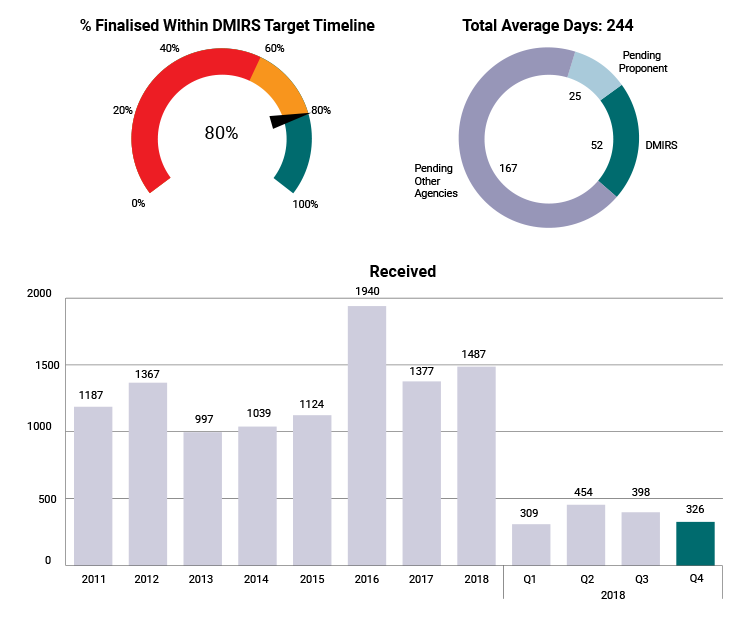
Calendar year 2018
The department received a total of 7,762 mining and petroleum applications during 2018, which is among the highest number of applications since 2009. Ninety one per cent of these were finalised within target timelines.
Table 1 provides the number of applications received each year, the agency performance and milestones.
Table 1: Number of applications, approval performance and milestones 2009 - 2018
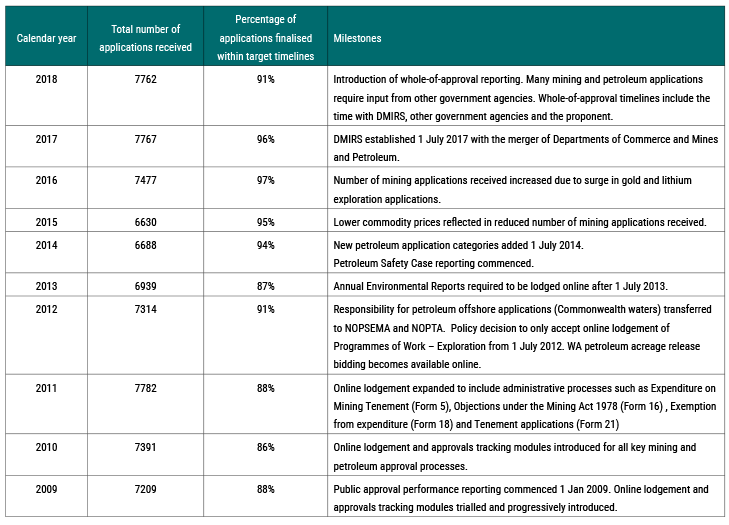
The agency performance target is to finalise more than 80 per cent of applications within target timelines. Target timelines for each approval process are listed in Table two below.
Review of DMIRS approval reporting
During the first half of 2019, the department will conduct a review of agency approval reporting. The scope of the review will include benchmarking DMIRS approval reporting with other jurisdictions, collaboration with other State government regulators and stakeholder consultation regarding future approval reporting options.
TABLE 2: DMIRS APPROVAL PERFORMANCE DECEMBER QUARTER 2018
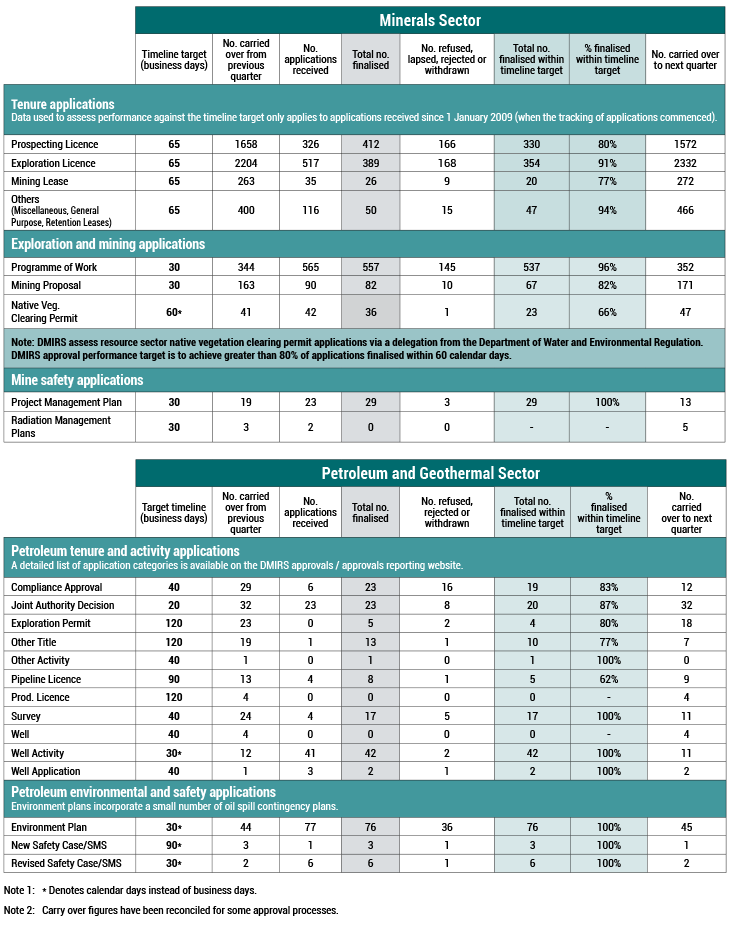
RER Group publications and subscriptions
The RER Group eNewsletter now replaces the following eNewsletters. You can still access the previous editions of these eNewsletters on the DMIRS website.
If you are a subscriber and would like to unsubscribe, click on the link provided in the covering email that delivered your RER Group eNewsletter. You will find this at the bottom of the email.
Minerals & petroleum
Weekly Native Vegetation Clearing Permit advertisements
Every week DMIRS advertises native vegetation clearing permit applications received and the decisions made. Clearing Permit decisions made are available for public appeal and submissions and appeals are to be made within the time period specified in the advertisement. Subscribe if you would like to be notified of Notifications of Clearing Permit Applications and decisions.
Western Australia’s Petroleum and Geothermal Explorer’s Guide
Western Australia’s Petroleum and Geothermal Explorer’s Guide 2014 Edition is designed to provide general information and guidance on the legislative framework for companies considering exploring and investing in Western Australia’s (WA) upstream petroleum and geothermal energy industries, and for companies currently involved in those industries. It may also be a reference for the public and other government agencies.
Mineral and Petroleum Statistics Digest
The Western Australian Mineral and Petroleum Statistics Digest contains key statistical information and analysis on the WA resource sector. Data covers mineral and petroleum quantity and values, royalty receipts, employment, mineral titles as well as listing contact details for principal producers. The publication is available electronically and is published for each financial year and calendar year.
Geological Survey of Western Australia
The Geological Survey of Western Australia (GSWA) is part of the department’s Geological Survey and Resource Strategy (GSRS) Division. GSWA conducts field-based research that provides solid, unbiased geoscientific advice to government, industry and the public.
GSWA commemorative booklet
The publication “The Geological Survey of WA: 130 years of geological excellence through the lens of its directors” celebrates GSWA’s 130th anniversary. This commemorative booklet can be downloaded for free from the department’s eBookshop.
GSWA eNewsletter
The GSWA eNewsletter is an online periodical newsletter that contains information on geophysical data releases, workshops, field trips, events, as well as latest releases of maps, books and digital data packages.
RSS feed
GSWA RSS Feed provides links to information and content as it’s released. Subscribe to the GSWA RSS feed.
Fieldnotes
Fieldnotes is a quarterly publication released by GSWA that provides the State's exploration industry and other geoscientists with an update on our latest work and ongoing programs. The publication provides updates on other GSWA products and services and is available free from the Information Centre located on the first floor of Mineral House, 100 Plain Street, East Perth 6004.
Geotourism & WA Unearthed
GSWA develops geotourism products to help tourists genuinely experience the magnificent geological heritage of Western Australia.
The WA Unearthed series presents an understanding of the geological evolution of the State that is the distillation of 30 years of geological mapping by GSWA and its collaborations with university and industry researchers. It emphasises the integration with precise geochronology and the contribution of high-quality isotopic, geophysical, and geochemistry datasets.
Catalogues
DMIRS
online catalogue accesses geoscience information including:
- geochronology records
- historical mining tenement maps
- hydrogeology reports (public)
- MRIWA reports
- mineralisation reports (public)
- mining proposals (public)
- Paleontology Reports
- Western Australian Mineral Exploration Index (WAMEX) (public)
Catalogue of geoscience products 1980–2009 lists all books, maps and digital packages published between 1980 and 2009.
Catalogue of pre-1980 geological publications lists all books published between 1898 and 1979.
eBookshop and other DMIRS publications and subscriptions
Publications
eBookshop - The
Department of Mines, Industry Regulation and Safety (DMIRS) has an eBookshop and many of the publications and PDF versions of books are free to download.
Prospect magazine - internationally circulated publication showcasing Western Australia’s dynamic resources sector.
Annual Reports - An archive of all Annual Reports providing an overview of DMIRS’ performance, budget papers, resource agreements and other strategic documents.
Latest News – DMIRS latest news articles, work in progress, upcoming events and stories relevant to industry.
Subscriptions
Twitter (@dmirs_wa) - Be the first to hear stories and follow DMIRS on Twitter.
DMIRS News Alert - subscribe for updates on DMIRS latest news articles, work in progress, upcoming events and stories relevant to industry.
Contact us
RER Group eNews
The Resource and Environmental Regulation (RER) Group eNewsletter is an online periodical newsletter that contains latest news, updates and events coming from the Resource and Environmental Compliance Division, Resource Tenure Division and the Geological Survey and Resource Strategy Division.
Subscribe
If you would like to stay informed about new products, services and other news from the RER Group, subscribe to our eNewsletter.
Unsubscribe
If you are a subscriber and would like to unsubscribe, click on the link provided in the covering email that delivered your RER Group eNews, you will find this at the bottom of the email.
RER Group contacts
The Department of Mines, Industry Regulation and Safety provides regulatory and policy oversight of the mineral and energy resources sector by overseeing the industry’s environmental standards, resource titles systems, worker health and safety, geoscience functions and dangerous goods legislation.
View contacts for the Resources Sector.